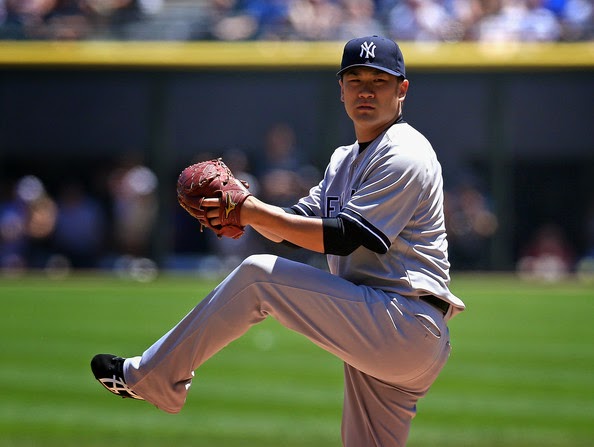(Courtesy of Getty Images)
(Originally published at IIATMS/TYA)
Almost a third of the way through the 2014 season, it would be hard to call Masahiro Tanaka's first year as a Yankee anything but spectacular thus far. In 10 starts, he's pitched to a 2.29/2.61/2.30 slash in 70.2 innings with 79 strikeouts and only 10 walks. His 28.5% K rate is tied with Zack Greinke for the best in MLB. His splitter might already be the single best pitch in baseball. He's got a 48.2% K rate on it and only a .318 OPS against. He's quickly become not only the most must-see player on the Yankees and their unquestioned ace in the face of all their rotation injuries, he's also become one of the must-see players in the entire league and one of the best pitchers in the game.
One of the biggest things the Yankees wanted to do with Tanaka this season was ease him into the transition from the Japanese Leagues to MLB. A major part of that easing was the extra rest Joe said he wanted to give him early in the season to get Tanaka's body and arm used to pitching every fifth day. Through both smart strategic and lucky weather-related decisions, Joe has employed that strategy perfectly through the first 2 months. Tanaka has made 6 of his 10 starts with 1 day or more of extra rest, and the extra time off actually has him 1 start behind almost every other top starting pitcher. The rest has certainly helped keep Tanaka fresh and served the purpose of scaling back his early workload, but has it made a difference in his performance? Let's check the numbers.
- Regular Rest (4 Starts): 29.0 IP, 21 H, 6 ER, 7 BB, 2 HR, 35 K (1.86 ERA/2.41 FIP)
- 5 Days Rest (4 Starts): 26.2 IP, 30 H, 10 ER, 2 BB, 4 HR, 26 K (3.37 ERA/3.42 FIP)
- 6 Days Rest (1 Start): 8 IP, 2 H, 0 R, 1 BB, 10 K
- 7 Days Rest (1 Start): 7 IP, 6 H, 2 ER, 0 BB, 1 HR, 8 K
You can throw out the 6 and 7-day starts as outliers, although it is interesting to see that Tanaka's monster first start against the Cubs was on 6 days rest. That was one of the weather-aided extra days he got. The split between the regular rest and 5-day rest outings, however, is noticeable and somewhat surprising. I think a lot of people expected Tanaka to struggle the most in the outings where he was getting shorter rest periods. 5 days off is closer to what Tanaka was used to in Japan, so it would be understandable if he had a start on that fifth day where his stuff wasn't as good as usual or his command wasn't as sharp. That simply hasn't been the case.
Save for the 6-day Chicago start, Tanaka has been at his best on a regular 4-day MLB rest schedule. He threw his complete game shutout against the Mets on regular rest. His 10-K second start against the Orioles was on regular rest, as was his 11-K start against the Angels at the end of April. He's given up fewer hits, he's given up fewer home runs, he's pitched deeper into games, and he's struck out more batters. Based on the numbers, Tanaka has been a better pitcher pitching on regular rest.
Those numbers do come with a pretty hefty SSS warning, and it would be hasty to declare Tanaka fully transitioned based on 8 starts. In a 4-game sample size, there are plenty of other factors that can determine outcome just as much as how well Tanaka is pitching. Tanaka's 4 regular rest starts have come at home against the O's and Angels and on the road against the Mets and White Sox. He's only made 1 start on 5 days' rest at home (against Tampa Bay) and 3 on the road (against Boston, Milwaukee, and the rematch with the Cubs). The extra road game and fact that he had to hit in 2 5-day games compared to just 1 regular rest game could have a bigger influence on the numbers than we realize. All we can really say right now is that it appears as though Tanaka is having no issues adjusting to the MLB pitching lifestyle. The numbers are better on regular rest, but it's still too early to say for sure that Tanaka is better.
That appearance alone is a positive omen for the rest of the season though, and should be taken as a positive just like the rest of Tanaka's sparkling numbers. Now that he's showing he can work every fifth day without fatigue or decline in performance, Joe should start to feel more comfortable using him on that schedule more and not seeking out extra rest days. The Yankees are at the point where they NEED Tanaka to take the ball every fifth day because he's the only reliable start-to-start pitcher they have in their rotation. The more he pitches, the better off this team is going to be. He's shown he can handle the environment, he's shown he can handle the competition, and he's showing he can handle the workload. Tanaka's ascension to new staff ace is almost complete.























No comments:
Post a Comment